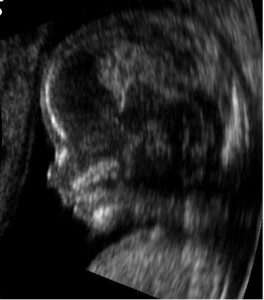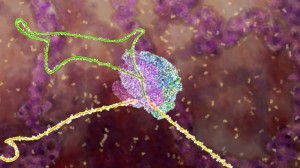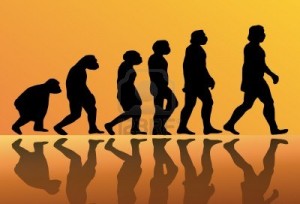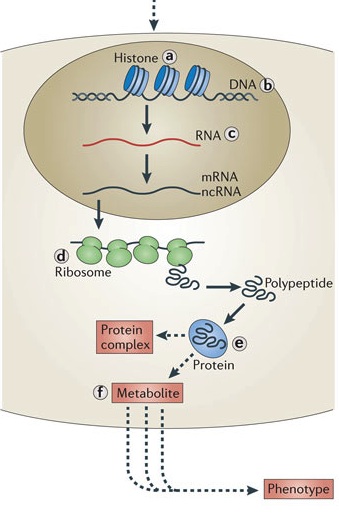 The remarkable and fairly rapid evolution of the human brain has been very difficult to explain. Previous posts have demonstrated that small and large non-coding RNAs in the brain as well as alternative RNA splicing have evolved much more rapidly in the humans, especially in the brain. Is it therefore possible that brain evolution can now be explained by genetic mechanisms? With the explosion in genetic information (see posts Mind and Molecular Genetics, New Genetic Landscape, ENCODE and Evolution) there is now some possibility that progress can be made in understanding brain evolution.
The remarkable and fairly rapid evolution of the human brain has been very difficult to explain. Previous posts have demonstrated that small and large non-coding RNAs in the brain as well as alternative RNA splicing have evolved much more rapidly in the humans, especially in the brain. Is it therefore possible that brain evolution can now be explained by genetic mechanisms? With the explosion in genetic information (see posts Mind and Molecular Genetics, New Genetic Landscape, ENCODE and Evolution) there is now some possibility that progress can be made in understanding brain evolution.
Elements of advanced human abilities have been shown in animals such as prosocial and cooperative behavior and use of symbolic and abstract symbols including elements of language (see posts). Chimpanzees, bonobos and other apes, for example are known to  demonstrate altruism, understanding others, social cooperation, tool use, and culture. Many other animals demonstrate social cooperation and even altruism, some culture. Of course, while an individual animal may surpass humans in one single ability, overall no other animal is as advanced as humans in cognitive areas.
demonstrate altruism, understanding others, social cooperation, tool use, and culture. Many other animals demonstrate social cooperation and even altruism, some culture. Of course, while an individual animal may surpass humans in one single ability, overall no other animal is as advanced as humans in cognitive areas.
Current research attempts to understand the extent of intelligence in both animals and early human ancestors in order to compare them to modern humans. But, this is difficult to accomplish. Research is just now describing differences in brain anatomy, both microscopic and organizational, between humans and other animals including human ancestors
How Important is Brain Size
A major difference between the human brain compared with other primates and human ancestors, is the comparative size relative to the body. Relative brain size in humans is greater than most animals, but not all; mice, for example, have larger relative brains. The human brain ratio is 200% larger than the chimpanzee, which is a great difference, and is mostly caused by a greater number of neurons. The amount of neurons that are created in the human ventricular zone is much more rapid in the human fetus and early infant. The greatest increase is in the regions for association in the pre frontal cortex, PFC. But, the reasons for this are not clear.
 The increased capacity from the greater number of neurons is only a small part of the cognitive increase. Humans also have increased number of glia per neuron, a greater space between neurons, and a very elaborate astrocyte network, sometimes called the “motherboard” of the brain, which is far more extensive than apes.
The increased capacity from the greater number of neurons is only a small part of the cognitive increase. Humans also have increased number of glia per neuron, a greater space between neurons, and a very elaborate astrocyte network, sometimes called the “motherboard” of the brain, which is far more extensive than apes.
Humans also have greater, neuropile, regions with few neuronal cell bodies but a lot of axons, dendrites, and processes from glial cells such as astrocytes. It is in some ways, a measure of connectivity. Humans have a greater density. But, in general there is very limited information about the microscopic differences between the brains of humans and apes.
Genetic studies of basic chromosomes have not revealed much because the differences between the human versus chimp or bonobo are 1% to 5%. But, other species have much greater differences. For example, the difference between the mouse and rat are 20% to 50%.
Previous posts have described extensive research into the differences of alternative RNA splicing, and the non-coding RNA’s. In non-coding regions comparing humans and apes there are more than 30 million differences, as well as another 50,000 differences in amino acids in proteins. This does not include significant differences in the 50% of the genome that are jumping genes, and many other types of genetic changes. But, these differences are just beginning to be understood.
When looking just at functional gene sites, and the surrounding regions, there are only a small number of specific changes in humans, compared with other human ancestors such as Neanderthals, Denisovans, and current apes. The question currently is whether these small number of genetic changes can have big effects.
Some Significant Gene Mutations Found
One very significant mutation is FOXP2, which is associated with language and speech. There are two different periods when this gene changed, the first with amino acid changes, and the second a more significant change that reorganized the circuit of connections. There are also several other notable gene mutations associated with brain size, as well as with receptors for dopamine, glutamate, and neuron development. Studies also looked at specific protein differences and metabolites involving multiple genes, cell types and differences in the timing of fetal development. Multiple gene effects may include spatial and temporally unique patterns in the developing human brain. The regulation can be looked at by the amount of different proteins and alternate transcripts.
With the technology advancing rapidly, the real limitation currently is the number of human and non-human brain samples that are available to study.
Possible Other Genetic Influences
As discussed in previous posts (Alt RNA splicing, Protein folding, microRNA’s) there are many factors that can affect brain evolution:
 Environment
Environment- DNA histone modifications and markers (the proteins that cover and protect DNA)
- DNA epigenetic markers – methylation
- Alternative RNA splicing multiple transcripts
- mRNA and long non coding RNA affecting the process
- Alterations at the ribosomes, different positioning
- Folding of the proteins
- Post transcriptional regulation from RNA binding proteins
- RNA editing
- Changes in the metabolism use of proteins
- ncRNA PIWI, and lincRNA
There are thousands of different microRNAs from apes to humans in the PFC, anterior cingulate cortex ACC, and general cortex. There are thousands of new mRNA (messenger RNA) in human brain and their development proceeded much more rapidly in evolution. But, these may or may not be relevant to changes in cognition and they are just beginning to be described.
In fact, there are few differences found between different regions of the human brain. The differences were only in primary visual cortex, cerebellum, and the caudate nucleus.
But, there were a few changes in the major human cognition regions related to social behavior, decision-making, attention, creativity and language – DLPFC, ACC and Broca’s area.
Strangely, these unique human qualities arose without major changes in functional organizational. This is true at the level of histology between monkeys and humans. Therefore, the unique human areas are similar to apes but they learned new skills.
Looking at Fetal Development for Clues
Human language and other cognitive abilities develop with input from environment through childhood and adolescence, although recent research shows surprising language abilities in the newborn. Infants deprived of human contact don’t develop these abilities and primate babies raised by humans don’t either. This implies that there is an important period of time when the human brain matures.
 The one dramatic finding in all of the research areas is the difference between humans and other apes in the rates of changes in babies pre frontal cortex, PFC. While the same genes were largely similar in the different species, a majority of the genes had changes in the timing of their ability to function in the period after birth across all species. What is striking about humans is the dramatic shift in the timing of these changes to delay maturation. This difference is up to five times greater in the PFC than the cerebellum. The PFC changes were related to the synapses. Compared to the PFC, other regions had little or no differences.
The one dramatic finding in all of the research areas is the difference between humans and other apes in the rates of changes in babies pre frontal cortex, PFC. While the same genes were largely similar in the different species, a majority of the genes had changes in the timing of their ability to function in the period after birth across all species. What is striking about humans is the dramatic shift in the timing of these changes to delay maturation. This difference is up to five times greater in the PFC than the cerebellum. The PFC changes were related to the synapses. Compared to the PFC, other regions had little or no differences.
The peak of these changes is at age 5 years in human PFC compared to several months in chimps.
Among these changes, synapse density is found to peak at 3 to 10 years of in PFC but 0.5 to 3.5 years in the auditory cortex and 3 months in the visual cortex. In monkeys and chimps all peaks of genetic changes in the PFC are shortly after birth compared to 3 to 10 years in humans. One theory is that the increased amount of synapses and the increased neuropile determines the slowly developing increased human cognition, but this is not proven.
 Another great maturational difference between humans and chimps is axon myelination, a sign of brain connectivity. Chimps and macaques peak at sexual maturity compared to humans peaking in the twenties.
Another great maturational difference between humans and chimps is axon myelination, a sign of brain connectivity. Chimps and macaques peak at sexual maturity compared to humans peaking in the twenties.
The major difference found thus far between humans and others is clear. In human infants the PFC stays immature and develops with a large amount of neurons over ten years during which most unique human cognitive abilities appear.
Changes in Brain Metabolism
Another place to look at differences is brain metabolism, which includes proteins, polysaccharides, and lipids in membranes, neurotransmitters, and energy molecules including all intermediate molecules. Most of the metabolism of energy, neurotransmitters, protein and lipid are similar in most species. But, thousands of genes and many metabolites are different between humans and other primates.
Humans uniquely use 20% of the body’s energy for the brain, compared with 12% for other primates and 1 to 8% for other vertebrates. Energy per density is the same in monkeys and humans.
- Some unique enzymes did develop in hominids such as the very important metabolism of glutamate, the major energy and neurotransmitter substance.
- Again, the PFC has greater amounts of metabolic changes than cerebellum.
- Glutamate was similar in adults in different species, but lower in human infants showing another maturational change.
There is, in fact, a great divergence of human metabolism from other primates, although it’s not clear how much diet and environment affect this. The lower glutamate in children are related to the slower cognitive development in humans.
Local or Broad Influences – Cis versus Trans
 The words cis and tran are important in genetics. Cis refers to a local effect in one small region, such as a change in a local shape that influences how DNA or RNA operates. Trans refers to effects that occur over a wide region by floating and traveling factors that generally influence genetic material.
The words cis and tran are important in genetics. Cis refers to a local effect in one small region, such as a change in a local shape that influences how DNA or RNA operates. Trans refers to effects that occur over a wide region by floating and traveling factors that generally influence genetic material.
Differences Between Species – Cis – Enhancer and promotor regions that are unique in humans are near genes for neural development. Most differences between humans and primates are cis, but do not appear to be significant for cognition.
Difference Between Species – Trans – Those changes that alter the amount of messenger RNA and micro RNA are more common in humans. These differences show relation to the functions of neurons in specific brain regions. There are an increasing number of miRNA that are significant.
The more frequent cis changes were not important for the evolution of cognition. A small number of trans changes affected circuits of hundreds of genes which alter fetal development. Although only a small number, the trans changes are significant for cognition.
Small Number of Genetic Changes Have Big Influence
A very small number of dramatic genetic changes seem to have a major influence. These include the following:
- FOXP2 related to language
- Zinc finger proteins, are transcription factors most likely to be related to cognitive changes and they have accelerated in humans, especially in PFC
- CLOCK genes are noted to be involved in neuropsychiatric disorders
- Four genes regulating neurons are important: MEF2A, EGR1, EGR2, EGR3.
- MEF2A may be the master gene in synapses in PFC – occurred after human-Neanderthal split.
- Several micro RNA changes are important in human PFC, and cerebellum, are not in chimps including miR-184, miR-92a and miR-454; miR-941 relates to neural function in humans and Denisovans
Human Brain Evolution
 There have been two general phases:
There have been two general phases:
First, there was a long gradual increase in brain size with cortical reorganization from eight million years ago until 200,000 years ago.
The second recent phase of regional developmental includes brain remodeling perhaps 200,000 years ago associated with cultural revolution.
Because cognition changes were so rapid in this second phase, it is possible that this is the reason that humans have not been insulated from problems such as psychiatric illness and abnormal brain development. Studies find a larger number of genes related to psychiatric illness than expected.
Brain Size in Ancestors related to Behavior
Below is an attempt to inexactly correlate the times of different brain sizes with cultural milestones, such as improvement in tools.
Million years ago is written as mya – Hundred thousand years is kya
8 to 2.5 mya
— — Common ancestor to australopithecines
— — Brain size of apes
3 mya – first stone tool
2.6 to 1.4 mya – Oldowan more advanced Flake tools
— — Expansion into Eurasia
2.3 to 1.6 mya – Homo habilis- head 1.5 x larger
1.9 mya to 200 kya – Home erectus – head 2 x larger
1.8 mya to 250 kya – Acheulean tools, handaxes
1 mya to 200 kya – Homo heidelbergensis – head 3x larger
1 mya – control fire
800 to 30 kya – Neaderthals, Denisovans – head larger than humans
200 kya – Homo sapiens sapiens –
— — Bone tools, fishing, shell ornaments, cave drawings
The fact that the Neanderthals and Denisovans had larger brains might not fit the theory that larger brain means more intelligence.
Another important fact is that the another ancestor, the small-brained Homo floresis, used stone tools with ape cranial volume.
Few Significant Mutations over Eight Million Years
 Below is another potential correlation of the few significant mutations with these same cultural innovations.
Below is another potential correlation of the few significant mutations with these same cultural innovations.
A small number of significant mutations correlate with human abilities. There have been two changes in FOXP2, the first is amino acid mutations very early, that may have not had much effect, whereas quite recently – 250,000 years ago – the regulatory changes surrounding the gene FOXP2 appear to be related to language abilities.
8 mya
6 mya – Ape like Brains
4 mya –
3 mya – First stone tools
— — Mutation – GADD45G Larger Brain
2 mya – Expansion to Eurasia
— — Mutation – SRGAP2 Increased signal processing
1 mya – Fire, Acheulian handaxes
— — Mutation HAR1 – Cortex expansion
— — Mutation FOXP2 amino acid changes
500 kya
— — Mutation – MEF2A Delayed Synapses PFC
200 kya – Bone tools, Fishing, cave engravings
— — Mutation – FOXP2 regulation Language
There are also confounding factors in these potential correlations. Brain size occurred well before the tech explosion and Neanderthals had even larger brains. The Neanderthals and Denisovans did not advance in tool use despite larger brains for over a million years. There are no symbolic artefacts from Neanderthals. Big advances only started 250,000 years ago with humans
Development and Brain Evolution
Research implies that the time of development of the brain, allowing greater periods of neuroplasticity, is, perhaps, the one very significant difference between humans and other ancestors and apes.
Humans generally develop 1.5 to 2 x slower than chimps. It is dramatic that human PFC maturation of synapses occurs from 3 years to 10 years compared to months for chimps and monkeys. Humans, also, have greater amount of cortical synapses and more plasticity for longer. Myelination is also very different with apes peaking at sexual maturation and humans in their twenties.
Brain Evolution
 There are many possible levels of genetic regulation and a huge amount of factors that could influence human cognitive development. Clearly, information is just beginning to emerge. But, current research points to the fact that a few very significant changes could have been crucial in the development of the human brain diverging from other apes, and from early ancestors. These changes affected the size of the brain, particularly the pre frontal cortex, with increased neuronal signaling and language. Computer calculations, taking into account many factors about mutations, also show that a small number (4) of significant changes might be the difference, since fixation into the population of these differences takes 50,000 years each.
There are many possible levels of genetic regulation and a huge amount of factors that could influence human cognitive development. Clearly, information is just beginning to emerge. But, current research points to the fact that a few very significant changes could have been crucial in the development of the human brain diverging from other apes, and from early ancestors. These changes affected the size of the brain, particularly the pre frontal cortex, with increased neuronal signaling and language. Computer calculations, taking into account many factors about mutations, also show that a small number (4) of significant changes might be the difference, since fixation into the population of these differences takes 50,000 years each.
Perhaps the most significant finding is that the development of the human brain in the child is delayed by years, which allows much more time for neuroplasticity to create monumental changes. This delay in the maturation of myelin, synapses and neuronal signaling is one of the major differences in humans compared with ancestors and apes.
The next post will look at some of the most recent findings about our human ancestors. It will discuss the changing conception of how long humans have been at their present level.
 Environment
Environment